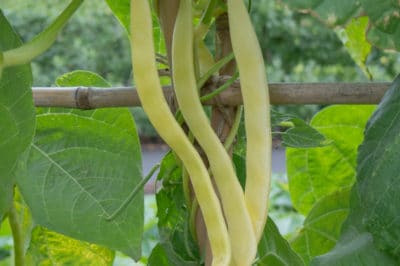Edible Pole Beans
String or green beans and lima beans are the most common edible bean varieties in the garden. However, there are others:
- Fabas – although not actually a vining bean, some grow six feet tall.
- Lima beans – grown for the seeds as shell or dry beans.
- Winged beans – a tropical bean, very high in protein.
- Asparagus or yard long bean – an Asian species; beans can reach 30 inches in length.
Ornamental Pole Beans
Runner beans and hyacinth beans are the two types most often grown for ornamental purposes. The scarlet flowers of runner beans attract hummingbirds and the beans are also edible. However, they do have strings that must be removed before cooking. Hyacinth beans are a different species and a tropical perennial. They have very showy flowers in colors ranging from purple through pink to white.
Half Runner Beans
Half runner beans don’t grow as tall as pole beans – usually three to four feet – but are definitely taller and floppier than bush beans. There are snap, shell and dry varieties, and some varieties can be used for all purposes. Half runner beans often do better with a trellis, but you’ll need to tie them up as they don’t twine like pole beans.
Growing Pole Beans
Although pole beans do need fertile soil, too much nitrogen will result in lots of bean leaves but few flowers or beans. Try spreading leaves on the bean rows in fall, then tilling in when soil warms and dries in spring. Soil should also drain well. Plant two or three weeks after the last frost. Beans need plenty of water but don’t like wet feet.
Trellises and Supports
Pole beans are surprisingly heavy, what with the weight of the vines and leaves as well as the bean pods. They are even more heavy when wet. You absolutely must provide them with a stout trellis, sturdy pole or support to grow on. If you’re growing them for ornamental purposes, you might want something fancy, but in the garden, a metal fence panel or bamboo poles work fine.
Harvesting Pole Beans
When to harvest pole beans is dependent on how you plan to use the beans. For green or snap beans, you want small, tender pods. The seeds should be just beginning to develop, so the pods will be round rather than lumpy. For shell beans, like limas, you want fully-developed beans that are still soft. For dry beans, allow to stay on the vines until completely dry and hard.
